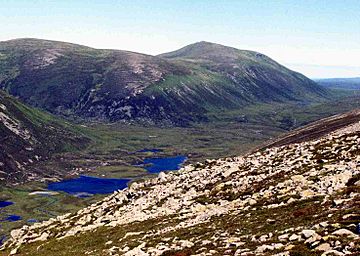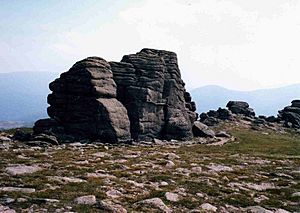Bynack More facts for kids
Quick facts for kids Bynack More |
|
|---|---|
| A' Bheithneag Mhòr | |

Bynack More seen from the slopes of Beinn a' Chaorainn across the Dubh Lochan.
|
|
| Highest point | |
| Elevation | 1,090 m (3,580 ft) |
| Prominence | 283 m (928 ft) |
| Parent peak | Ben Macdui |
| Listing | Munro, Marilyn |
| Naming | |
| English translation | Vague |
| Language of name | see text |
| Geography | |
| Location | Cairngorms, Scotland |
| Parent range | Grampians |
| OS grid | NJ042063 |
| Topo map | OS Landranger 36, OS Explorers 404, 403 |
| Listed summits of Bynack More | ||||
| Name | Grid ref | Height | Status | |
|---|---|---|---|---|
| A’Choinneach | NJ032048 | 1017 m (3337 ft) | Munro Top | |
| Bynack Beg | NJ036068 | 970 m (3182 ft) | Munro Top | |
Bynack More is a Scottish mountain located in the Cairngorms range. It stands about 16 kilometres (10 miles) east-south-east of the town of Aviemore in the Highland region. Its name in Scottish Gaelic is A' Bheithneag Mhòr or Beinn Bheithneag.
About Bynack More
Bynack More is a special kind of mountain known as a Munro. This means it is a Scottish mountain over 914.4 metres (3,000 feet) tall. It is also a Marilyn, which is a hill with a drop of at least 150 metres (492 feet) on all sides. Bynack More reaches a height of 1090 metres (3576 feet).
It stands a little apart from the other big peaks in the Cairngorms. This means people often climb it on its own. Like many mountains in the Cairngorms, Bynack More has a large, flat top, like a high tableland, called a plateau. However, from some angles, it can look like a cone.
The plateau is famous for its huge granite rock formations called tors. These are known as the Barns of Bynack. They look like giant stone buildings.
The meaning of the mountain's name from Gaelic is not completely clear. Some ideas include "kerchief or a cap," "big little mountain," or "chimney pot," possibly referring to the tors on its summit. In the past, it was also called Ben Bynack or Caiplich.
Exploring Bynack More's Geography
Bynack More is a long hill that stretches from north to south. Its eastern sides are very steep and rocky. They drop about 300 metres (984 feet) down to the start of the Water of Caiplich river.
The mountain has two smaller peaks nearby:
- Bynack Beag is about one kilometre (0.6 miles) to the north-west. It is 964 metres (3163 feet) high. It's easy to climb when you approach Bynack More from the north. Bynack More and Bynack Beag look like twin peaks from the north.
- A’Choinneach (which means "Boggy Hill") is 1017 metres (3337 feet) high. It is located 1.5 kilometres (0.9 miles) to the south-west. This peak used to be a Munro, but it was reclassified in 1981. It's an easy climb with less than 80 metres (262 feet) of uphill walking from the main mountain.
You can also climb Bynack More along with the nearby Cairn Gorm. These two mountains are connected by a high, low point called a col, known as The Saddle (807 metres or 2648 feet).
The most exciting feature on Bynack More's plateau is the Barns of Bynack. These impressive granite rocks are about 500 metres (0.3 miles) south of the summit. The tallest ones are roughly six metres (20 feet) high.
How to Climb Bynack More
The most popular way to climb Bynack More starts from Loch Morlich. You follow a good path that goes through the beautiful Ryvoan Pass, where you'll see the charming Lochan Uaine (which means "green lochan" or small lake).
The path then turns east, crossing the River Nethy. After that, you climb the northern ridge of Bynack More to reach the top.
Another way to climb is to start from the car park at the Cairn Gorm ski centre. From there, you can climb Cairn Gorm first and then continue to Bynack More by crossing The Saddle. However, this route can be quite rough and challenging.
At the summit, you'll find a pile of granite boulders. From here, you get amazing views of Cairn Gorm across the rocky sides of Strath Nethy. The Ben Avon plateau can also be seen clearly.


